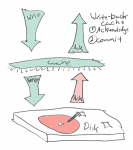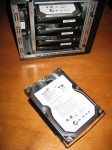This week’s links focused on the MacBook Air, and Iomega’s USB 3.0 SSD. On the enterprise side, we have HP’s new training programs, server virtualization assumptions, the rise of the storage industry, and another great piece by Chris Evans.
Virtual Storage
The Four Horsemen of Storage System Performance: Never Enough Cache
Perhaps the previous discussion of spindles left you exhausted, imagining a spindly-legged centipede of a storage system, trying and failing to run on stilts. The Rule of Spindles would be the end of the story were it not for the second horseman: Cache. He stands in front of the spindles, quickly dispatching requests using solid state memory rather than spinning disks. Cache also acts as a buffer, allowing writes to queue up without forcing the requesters to wait in line.
SMB Arrays: Drive Carriers Or Not?
One reason I decided to work with the folks at DCIG to collect data for their Small Business Storage Array Buyers’ Guide was to learn more about the various products in the space. One difference I noted in these small arrays, which usually hold 4 to 8 drives, is their use of hard disk drive carriers or sleds. There are pros and cons to both approaches, but I was pleased to see that all arrays so far include everything needed to install a drive.
Is NFS v3 Really That Bad?
Did some pNFS proponent slip a love potion into the coffee at EMC? Suddenly it’s pNFS time at the company known for its reluctance to embrace file sharing and filesystems in general. The purple prose is flying, with Chad Sakac declaring himself “a big fan of the application of NFS” and Chuck Hollis extolling the “inherent simplicity and ease-of-management of NFS.” The NetApp guys must be amused by the bear hug from Hopkinton, but many are seeing deja-vu all over again.
Hitachi GST Joins WD On The “Advanced Format” Hard Disk Drive Bandwagon
Another limit is being pushed in computers: The 32-bit LBA addressing mode. Hard disk drives have simply become too big for the 2.1 TB allowed by 32-bit LBA and 512 K sectors. Western Digital was first to answer this challenge with “Advanced Format”, and Seagate took an alternate 48-bit LBA route. Now Hitachi GST introduced an Advanced Format drive of their own. Will the industry ever adopt 48-bit LBA?



